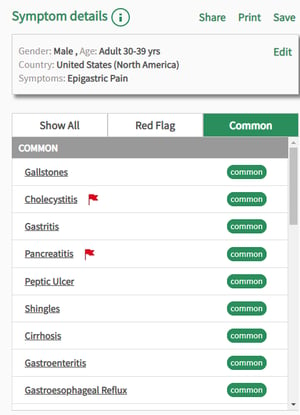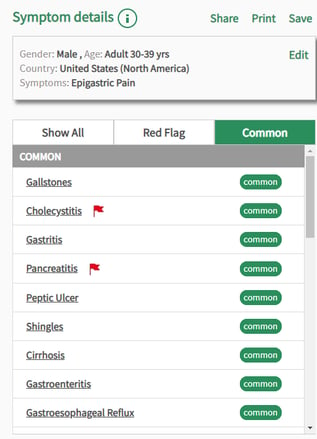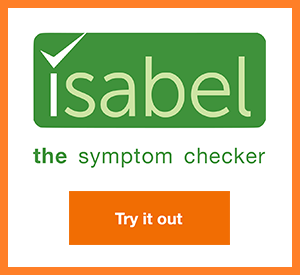- Privacy Policy
- Terms & Conditions
- Contact us
- ©Isabel Healthcare 2025
Epigastric pain symptoms and causes - Isabel Healthcare
 Everyone has experienced stomach pain at some point in their life. Often the cause is obvious, such as a stomach bug or too many sit ups at the gym, and the symptoms will disappear in a day or two. Sometimes, however, the cause of a stomach ache isn’t clear, and this can be quite unnerving. There are a few clues when assessing the cause of a stomach ache, and one of these clues is the location. If your stomach ache is in a particular area of the stomach, or abdomen, you can eliminate other causes and narrow down to the cause. One such type of stomach ache dictated by the area of the abdomen is called epigastric pain.
Everyone has experienced stomach pain at some point in their life. Often the cause is obvious, such as a stomach bug or too many sit ups at the gym, and the symptoms will disappear in a day or two. Sometimes, however, the cause of a stomach ache isn’t clear, and this can be quite unnerving. There are a few clues when assessing the cause of a stomach ache, and one of these clues is the location. If your stomach ache is in a particular area of the stomach, or abdomen, you can eliminate other causes and narrow down to the cause. One such type of stomach ache dictated by the area of the abdomen is called epigastric pain.
What is epigastric pain?
The upper part of your abdomen, which sits below your rib cage, is known as the epigastrium. Your pancreas sits within the epigastrium, as well as parts of your small intestine, stomach and liver. Pain or discomfort below your ribs in this area of the upper abdomen is called epigastric pain. As well as the epigastric pain you also may get some other symptoms including heartburn (indigestion), stomach bloating and excess gas (trapped wind).
Causes of epigastric pain
The Isabel symptom checker can help you understand your epigastric pain symptom and research possible causes to discuss further with your healthcare provider. Place all your symptoms, even if they seem unrelated, into the symptom checker, and select the different possibilities to research each diagnosis further, then discuss your findings with your doctor.

Common epigastric pain causes
Due to the body organs located within the epigastric area, epigastric pain is commonly caused by:
- Pancreatitis - The pancreas produces enzymes which helps your body digest food and hormones including insulin which helps regulate your blood sugar level. These enzymes leave the pancreas and become active in the small intestine. If the enzymes become active within the pancreas then they can cause pancreatic inflammation, which is known medically as pancreatitis. Other symptoms include burning stomach pain, nausea, vomiting, stomach swelling and tenderness around the stomach.
- Gallstones - The gallbladder is a small pear-shaped organ on the right side of your abdomen beneath the liver. The gallbladder stores bile which is released into the small intestine when you eat and breaks down the fats in the food you consume. When the bile constituents become out of balance gallstones can form and if one becomes trapped in the opening of the gallbladder then it can cause severe epigastric pain. If gallstone disease is left untreated or isn’t recognized, then symptoms of yellowing of the eyes and the skin, known as jaundice, and a fever may occur. If the gallstones move into the pancreas then pancreatic inflammation may occur resulting in pancreatitis (see above).
- Peptic ulcer or stomach ulcer - These are sores that occur in the stomach lining and are known as gastric or peptic ulcers. The sores occur due to an imbalance of digestive fluids within the stomach or small intestine. As well as causing epigastric pain, other symptoms are indigestion, heartburn, nausea, vomiting blood (hematemesis) and rectal bleeding
- Gastritis - This is inflammation or irritation of the stomach lining. Excessive alcohol use, chronic vomiting, stress or the use of medications including aspirin or anti-inflammatory drugs can cause gastritis. As well as epigastric pain, other symptoms include stomach bloating, vomiting, nausea, indigestion, loss of appetite and vomiting blood.
Other causes of epigastric pain
Causes not linked to the organs within the epigastric area include:
- Gastroesophageal reflux disease (GERD) - If stomach acids flows backwards from the stomach to the food pipe, or esophagus, this is called acid reflux. This acid can then irritate the esophagus lining, which causes epigastric pain resulting in GERD. Other signs that you may have GERD include a chest burning sensation after eating, which may be worse at night, chest pain, difficulty swallowing and food regurgitation.
- Gastroenteritis - This is inflammation or irritation of the digestive system, caused by various viruses and bacteria. Symptoms include epigastric pain, nausea, vomiting, or diarrhea with a duration under two weeks.
Due to many organs being present in the epigastric area, identifying the cause of the epigastric pain can be difficult, especially as many of the diseases share the same symptoms. The Isabel Symptom Checker can help you evaluate all the symptoms you are experiencing and research the causes and where to present for care, so that your health provider can decide what next steps to take in order to ensure you receive a timely diagnosis and explanation for your symptoms.
Am I at risk of epigastric pain?
Epigastric pain risk factors include a history of peptic ulcer disease, consumption of nonsteroidal anti-inflammatory drugs (NSAIDs) including aspirin, heavy alcohol consumption, and overeating.
How you can help your doctor
Before your consultation with you doctor, think about the following questions they may ask you:
- Describe your epigastric pain. Is it worse after eating (postprandial epigastric pain) or worse at night (nocturnal epigastric pain)?
- Is there a trigger associated with your epigastric pain?
- How many episodes of epigastric pain have you experienced in the past week?
- Does anything help alleviate your epigastric pain?
- Do you have any other symptoms? For example, vomiting blood, nausea, indigestion or rectal bleeding?
- When is it an emergency?
It is often difficult to differentiate epigastric pain from other causes of stomach pain. Symptoms can radiate so the pain you are experiencing may be in a different part of your abdomen. If you experience a sudden severe stomach pain or a pain that feels tearing or ripping, then you should seek emergency care straight away. Other symptoms accompanying the stomach pain which should be treated as requiring urgent attention include vomiting, bloody diarrhea or fever. If you feel your symptoms are persistent or worsening, then you can place your symptoms into the Isabel Symptom Checker and you should seek care.

Mandy Tomlinson
Mandy has worked for Isabel Healthcare since 2000. Prior to this, she was a Senior Staff Nurse on the Pediatric Infectious disease ward and high dependency unit at one of London's top hospitals, St Mary’s in Paddington which is part of Imperial College Healthcare NHS Trust. Her experience in the healthcare industry for the past 33 years in both the UK and USA means she's a vital resource for our organization. Mandy currently lives and works in Scottsdale, Arizona.
Subscribe Here!
Recent Posts
Isabel DDx Companion with ChatGPT Integration - to help you diagnose even faster
At Isabel Healthcare, we’ve always been driven by one goal: to make clinical reasoning faster,..Virtual Triage: Do more questions lead to better patient outcomes?
One of the common misconceptions related to virtual triage / symptom checker tools is that the more..List Of Categories
- Differential Diagnosis Decision Support
- Differential diagnosis
- Symptom Checker
- Symptoms
- Medical Error
- Patient Disease Information
- Disease
- Clinical Decision Support
- Diagnostic Decision Support
- Isabel 1 Minute Read
- Diagnosis Error
- Diagnosis Skills Cases
- Healthcare Informatics
- Clinical Reasoning
- Evidence-based Medicine
- Medical Education
- Patient Engagement
- Symptom Triage
- Nurse Practitioner Education
- Nursing Decision Support
- Partnership
- Public Health
- COVID-19
- EHR
- Patient Empowerment
- Patient Safety
- rare disease

Start your FREE Trial today
Try the Isabel Pro DDx generator for 30-days - no payment card details required.




